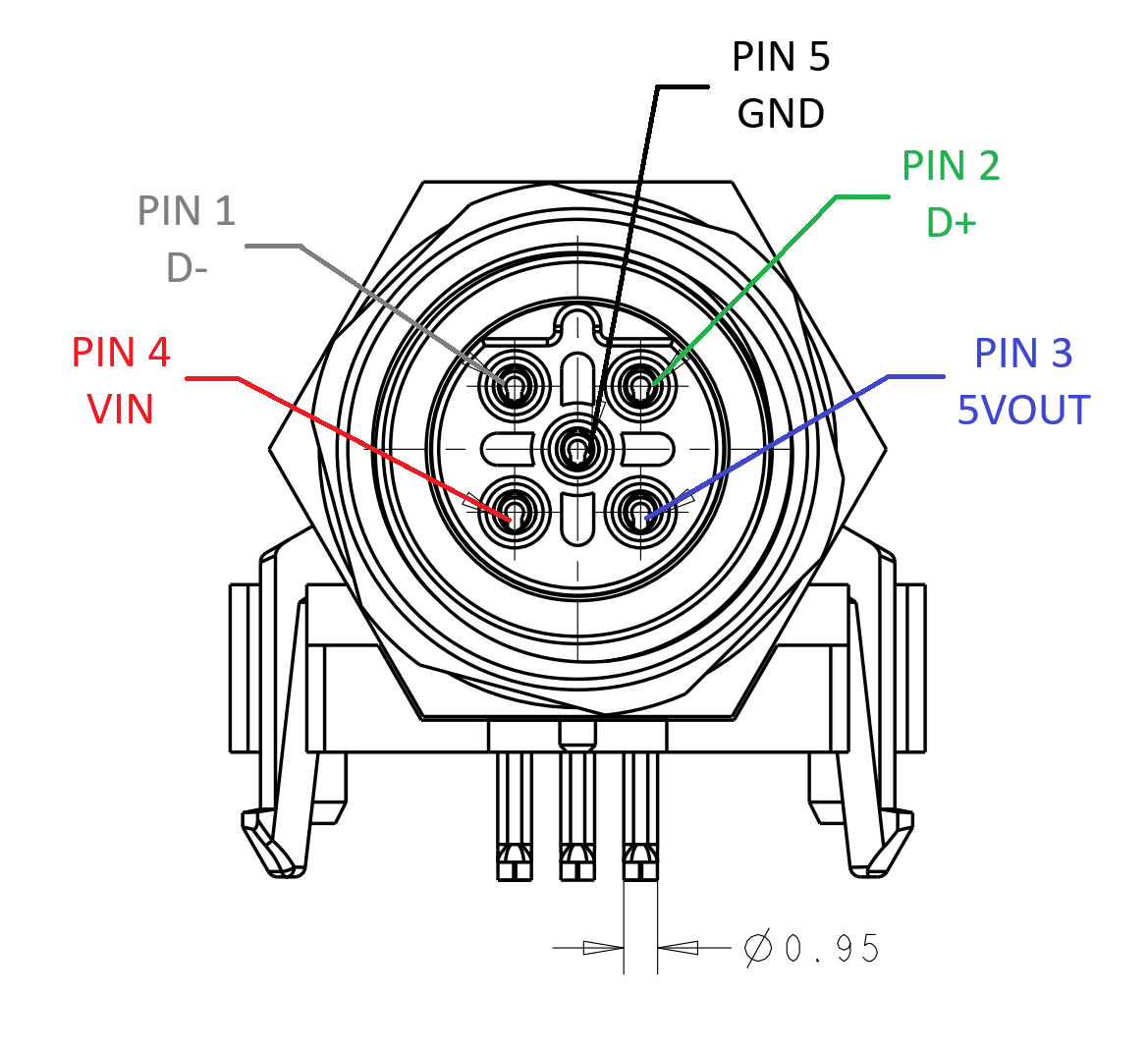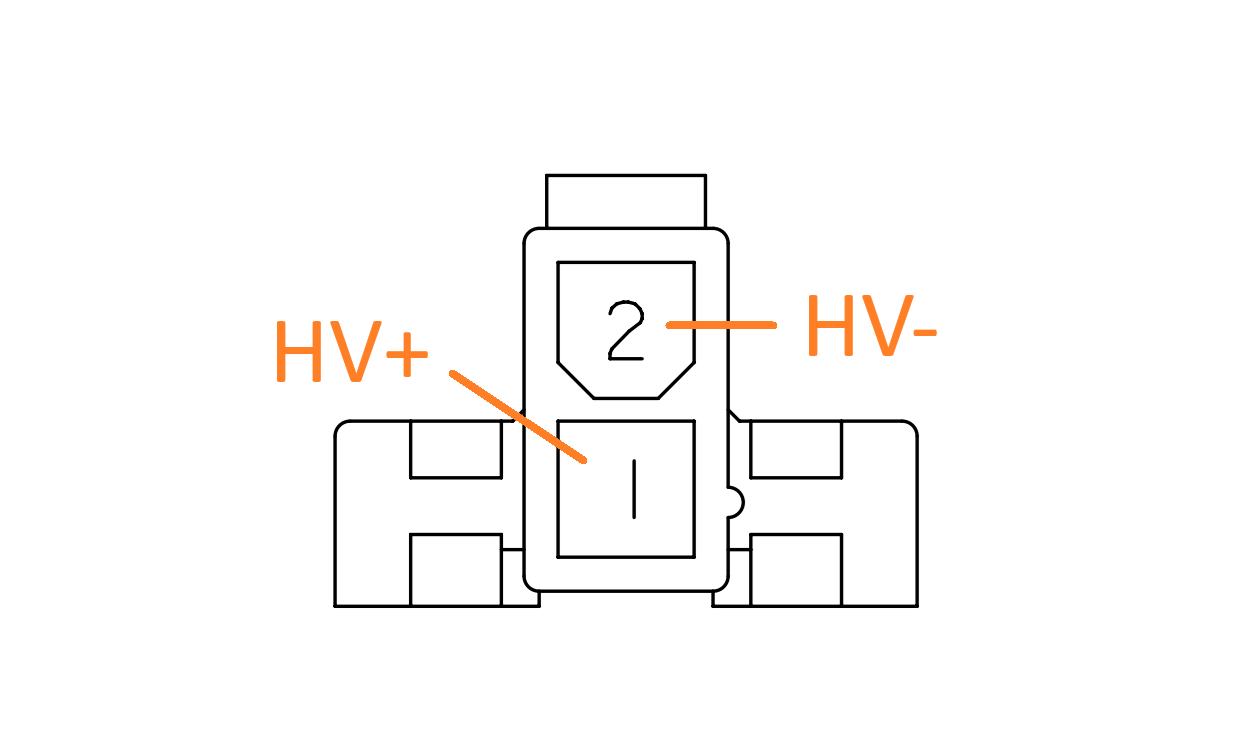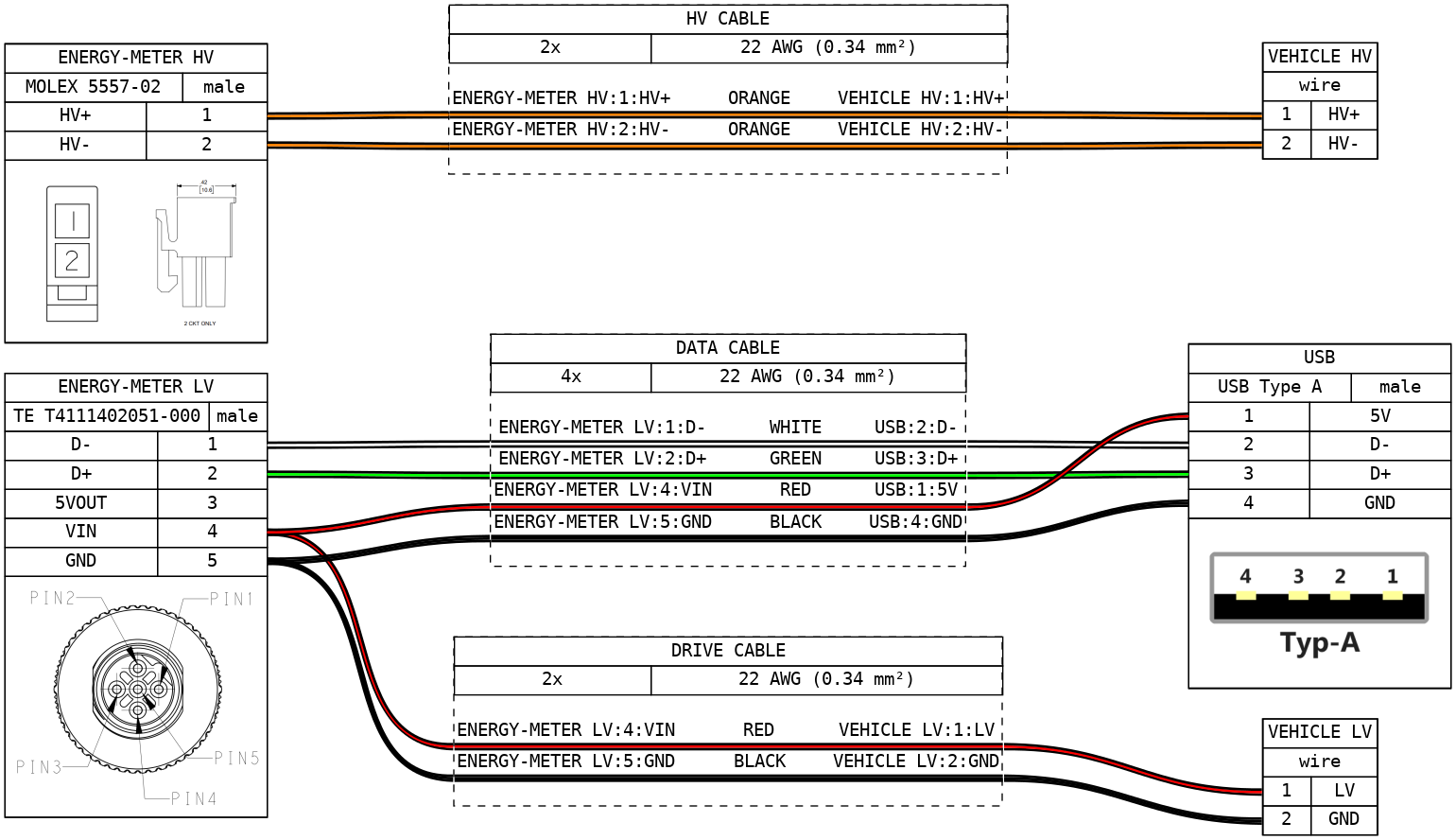- Records the following values:
- HV bus voltage
- HV bus current
- LV supply voltage
- Ambient (CPU) temperature
- Real-world time of each records
- 100 Hz data sampling rate
- Mounted as a USB Mass Storage device
- Data visualizer available on most platforms
| MIN | TYP | MAX | UNIT | |
|---|---|---|---|---|
| Supply voltage1 | 6 | 28 | V | |
| Power consumption | 0.25 | 0.5 | W | |
| HV bus voltage | 0 | 600 | V | |
| HV bus voltage resolution | 0.24 | V | ||
| HV bus current | -750 | 750 | A | |
| HV bus current resolution | 0.64 | A | ||
| Operational temperature | -10 | 80 | °C | |
| IP rating | IP 20 | |||
| Startup time | 570 | 600 | ms | |
| Record interval | 10 | 15 | ms | |
| Possible data loss on power brownout |
0 | 100 | ms |
1 When powered by USB, the device can startup with a minimum supply voltage of 4.5 V.
| LV | HV | |
|---|---|---|
| Model | T4145415051-001 | 39291028 |
| Image |  |
 |
| Mate | T4111402051-000 | 5557-02 |
| Pinout | 1: D-2: D+3: 5VOUT14: VIN5: GND |
1: HV+2: HV- |
1 5VOUT is not used by the device. It outputs 5V and can drive current up to 800mA.
Caution
Misconnection of the pins may cause permanent damage to the device.
Warning
When powered by USB, 5V rail of the USB must be connected to VIN, not 5VOUT.
There are 2 operation modes in the FSK-EEM device. When the FSK-EEM is in startup, it measures the LV supply voltage and decide the mode to run.
If VIN >= 6V during startup, the device enters the record mode.
The device measure HV voltage, HV current, LV voltage and the CPU temperature every 10 ms.
Log files are created for every power cycles and synchronized every 100 ms.
During the file write, measurement may delayed up to 15 ms.
Important
The device performs a zero calibration of the HV voltage and current during the startup sequence.
Make sure that the HV voltage and current are at 0V and 0A until the the startup is complete.
If VIN < 6V during startup, the device enters the USB mode.
When plugged in, the FSK-EEM USB Mass Storage will appear on the host PC.
It may took ~20 seconds to be mounted. See Troubleshootings for the details.
The recorded log files are stored in the drive like a standard USB memory stick.
Note
The drive is read-only. You cannot edit or delete the log files in the explorer.
Important
The timestamp part at the beginning of the log file's name is important to calculate the actual timestamp.
Do NOT edit the filename of the *.log file. JSON or CSV files are not affected.
Download the latest FSK-EEM Viewer from the Release or open the online viewer.
Open the record file in the FSK-EEM Viewer to visualize the data or export as a human-readable format.
Click the Connect button and select the FSK-EEM device to connect.
The device's UID and the current time are displayed on successful connection.
Sync RTCbutton synchronizes the device clock with the host computer.Deletebutton deletes the all log files stored in the device.
Unplug and re-connect the device to see the change.
Download the latest fsk-energymeter-pcb-<version>.zip from the Release.
The gerbers/ directory includes the gerber, BOM and CPL files for the JLCPCB PCBA(SMT) order.
Tip
Exclude through-hole components (connectors, debug pin header and the hall sensor) from the SMT assembly list. Purchase these parts from the global suppliers and solder it yourself for cheaper price and reduced setup fee.
Download the latest fsk-energymeter-firmware-<version>.zip from the Release and upload the firmware-release.elf to the device with ST-Link.
- Make sure following executables are in the
$PATH.- arm-none-eabi-gcc
- openocd
- make
- Common
- Windows
- MacOS
brew install make openocd
- Linux
sudo apt-get install build-essential openocd
- Clone repository
git clone https://github.com/luftaquila/fsk-energymeter.git --recursive
cd fsk-energymeter/device/firmware
make program # release build
make debug # debug build- Node.js >= v20
- Rust >= 1.81.0
- Clone the repository and install dependencies
git clone https://github.com/luftaquila/fsk-energymeter.git --recursive cd fsk-energymeter/viewer/web npm install cd ../native npm install
-
Web
cd fsk-energymeter/viewer/web python -m http.server 80 # open http://localhost
-
Native
cd fsk-energymeter/viewer/native npm run tauri dev # run npm run tauri build # build executables
The FSK-EEM uses the STM32F401, which implements a USB Full Speed PHY. It is decades-old technology with a maximum transfer speed of 12 Mbit/s. However, in the real world, the actual speed is around 4 Mbit/s or 0.5 MB/s.
When you plug the FSK-EEM device, the host(PC) will try to load the FAT table of the SDMMC into its memory. The size of the FAT32 FAT table is around 8 MB, so it took ~20 seconds for the FSK-EEM to be successfully mounted on the host computer. This is a hardware limitation in exchange of the lower cost.
The RTC sync or record delete functions will work immediately regardless of this limit.
FSK-EEM Viewer's Device Configuration tab uses the Web Serial API to talk with the device, which has limited support across the platforms and browsers.
On MacOS, the native app uses the Safari for its WebView, which does not supports the API. The web version(URL or html file) of the FSK-EEM Viewer will work on the Chrome browser.
On Android and iOS, the API is not supported from the OS layer. Use the desktop version of the viewer to configure the device.
"THE BEERWARE LICENSE" (Revision 42):
LUFT-AQUILA wrote this project. As long as you retain this notice,
you can do whatever you want with this stuff. If we meet someday,
and you think this stuff is worth it, you can buy me a beer in return.

